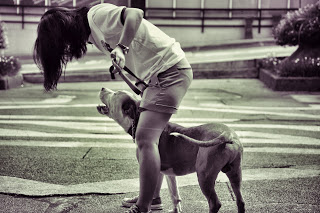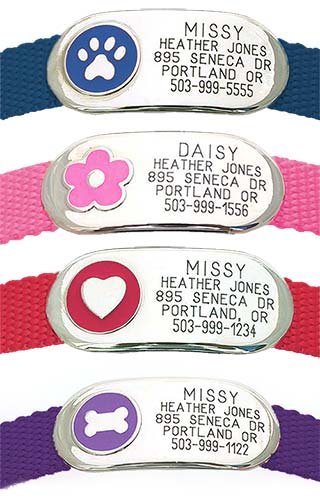
Most people mistakenly assume that having a large backyard for their large breed dog allows for adequate exercise for their dogs. This is a misconception that needs to be addressed. Labrador Retrievers, Golden Retrievers, German Shepherds and other larger breeds rarely exercise themselves in a backyard. Do you see them trying to have a good cardio workout by exercising diligently for 40 minutes? Do you see them breaking into a sweat and start panting and have to sit down because they have pushed themselves to a high level of workout fitness? It does not happen often.
In reality, you probably notice that your dogs pant but that’s probably because it’s hot outside while they take a stroll around the backyard. Mostly, they are sniffing around looking for squirrels, or barking at the stranger who walks by. Once in a while, your dog might get a sudden burst of energy and start tearing up and down your yard as if it was running on the football field. Yet, that doesn’t last very long at all. And if you did actually meet a dog who ran around berserk in the backyard for hours, it is a good indication that that dog is not trying to exercise itself but that it has other problems.
Otherwise, your dog may just lie on the grass and enjoy the afternoon sun. Around the house, your dog might stroll around and follow you or your family members from room to room. Sometimes, someone might throw the ball or a frisbee several times to play fetch with the animal. When all is said and done, especially for large dogs, this is definitely not the exercise and stimulation that your dog needs.
While it is ideal that we feed our dogs high quality commercial dog food packed with high amounts of protein, appropriate nutrients, and sufficient calories to sustain the normal energy requirements of a dog, we seem to fail to implement a healthy exercise regime for our dogs. It is no wonder that we are seeing an increased incidence of obesity in dogs and the resultant obesity-related health problems. Such health problems include diabetes mellitus, congestive heart failure and an increased risk of arthritis in aging dogs, etc. The answer to obesity may very well be portion control and not feeding your dog bacon scraps from the kitchen, but above that, a much more pressing and beneficial solution is simply exercise.
Dogs are highly intelligent beings needing physical and mental stimulation just like we do. It turns out that walking around the yard isn’t as physically or mentally stimulating as we hoped it might be. The solution to this is to actually take your dog out for a good walk or a jog. That way, your dog can be mentally and physically stimulated by interacting with the outside world.
Dogs look to their owners for leadership. In the wild, dogs follow their leader and together, they travel together as a pack, roaming for hours to find food. The leaders are the ones who lead the pack, tell the pack when and where to run or roam, and tell them when and where to rest. Naturally, dogs don’t just decide to run off to exercise on their own, unless they have decided to leave the pack for some reason. Because the pack keeps alive by functioning as a unit, it is vital that dogs don’t decide to run off on their own somewhere else. A dog that does that would certainly be what we humans call “misbehaving”.
The responsibility to implement a workout regime for our animals lies on our shoulders as owners. Dog owners must undertake this leadership role. If there is no leadership in the house or the life of your dog, your dog’s natural instinct is to assume its own leadership, which results in your dog running amok in the house and disobeying you because you are no longer its leader. Exercising with your dog is one of the first and foremost important activities that you must share with your pet. First, it puts you in the leadership role – when you are exercising with your dog outside the house, your dog has to pay attention to you and read your verbal or physical commands so the both of you can exercise as a unit. Having your dog concentrating on you and at the task at hand certainly has obedience training benefits, and it keeps your dog’s mind sharp and engaged. Second, it helps to expend your dog’s energy so it does not need to find other means to release its pent up energy by herding family members, being aggressive, or chewing up your couch. Third, it keeps your pet healthy, happy, physically, and mentally stimulated.
So how much exercise is adequate for your dog? That is indeed a difficult question to answer since there are so many breeds of dogs with different physical needs. As a general rule of thumb, larger breeds require more exercise than smaller breeds, although smaller breeds also require exercise outside the house for the same reasons as was previously discussed. The larger the breed or the higher the energy level of the dog, the more exercise it needs. Start with 40 minutes of walking/jogging a day and add more exercise time as your dog requires. After a good bout of exercise your dog should come home and be happy to curl up on the floor and get some rest.
Another important note to add is that play time is not exercise time. Exercise time is an extended period of time in which your dog needs to concentrate on you or a task at hand, get a good cardio work out, and practice discipline. Think about exercise time as work time for your dog. Play time is an extra activity as a treat for your dog to relax or get excited about. Play time constitutes toys (ball, Frisbee, etc) or going to the dog park to socialize with other dogs, or prancing around in the water by the beach.
Everybody knows that living in the modern society means a more hectic schedule which equates to less time for our animals. Exercise improves mental and physical health and it cannot be stressed enough that not only does this law of nature apply to humans, it also applies to the health and well-being of our animals.
By Serene Lai – Pets.ca writer
 Pit
Are we the ones frightened or are we the ones
Pit
Are we the ones frightened or are we the ones
 Name Tags for Dog Collars
For most people, our dogs ar
Name Tags for Dog Collars
For most people, our dogs ar
 Are Vaccines Bad For Your Dog?
The vaccine controversy. Eve
Are Vaccines Bad For Your Dog?
The vaccine controversy. Eve
 Designer Dog Collars
Your dog can be stylish too!
Designer Dog Collars
Your dog can be stylish too!
 A Review of The Invisible Fence
Chubbymy pet LabradorI have a pet dog, named him Buddy, he i
A Review of The Invisible Fence
Chubbymy pet LabradorI have a pet dog, named him Buddy, he i
Copyright © 2005-2016 Pet Information All Rights Reserved
Contact us: www162date@outlook.com